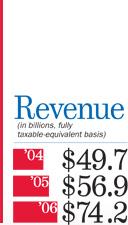Chairman,
Chief Executive Officer
and President


Stong financial performance yet again.
In 2006 Bank of America earned a record $21 billion. While earnings were up 28 percent on a 30 percent rise in revenue, much of that increase was driven by the addition of MBNA. A better measure of the year's success was the 14 percent increase in diluted earnings per share. Adding MBNA's results back into our 2005 financial results to create an apples-to-apples comparison, revenue was up 10 percent in 2006 while we controlled expenses and achieved merger-related savings.This strong financial performance has enabled us to continue our record of returning capital to shareholders. 2006 was our 29th consecutive year of raising our quarterly dividend, which increased by 12 percent to $0.56. Over that time, our dividend has increased at a compound annual growth rate of 13 percent. We also returned $9.5 billion to shareholders in 2006 by repurchasing shares.
Last year's financial results were gratifying, given external headwinds our industry faced in 2006 in the form of a flat-to-inverted yield curve and rising credit costs, which we will most likely continue to face in 2007.
The yield curve continues to be flat to inverted. The curve represents the spread between short- and long-term interest rates and is an indicator of the opportunity that banks have to generate net interest income.
We believe we are better positioned than many of our competitors in this environment. Our revenue mix is now more than 50 percent fee income, and this change in mix has allowed us to continue to operate within our long-term target of 6 to 9 percent annual revenue growth even as net interest income growth has been reduced to low single digits.
The normalization of credit costs has long been anticipated. Credit costs have remained historically low across most segments of the economy during the recent years of economic expansion. As net charge-offs and provision expense normalize, bank earnings will be pressured.
We believe we are in a good position to weather any credit issues we currently see on the horizon. The breadth of our franchise across geographies, market segments, industries and asset classes makes our credit portfolio inherently diverse and granular. Our ability to distribute credit risk through the securitization of various asset classes adds further stability. And as our risk managers analyze information about our customers in ever more sophisticated ways, we can grow our portfolio without significantly increasing our risk profile. In fact, in some parts of our business we are actually saying "yes" to more customers while at the same time improving the average quality of our loans.
Operating leverage is perhaps our most important answer to both the yield curve and credit costs. We have consistently demonstrated our ability to manage expenses and produce positive operating leverage — the difference between the rate of revenue growth and the rate of expense growth. This performance enables us to invest in our businesses even when revenue is under pressure.
Next: The company we're building.